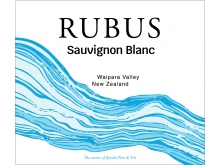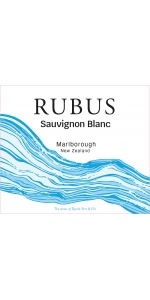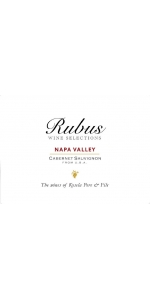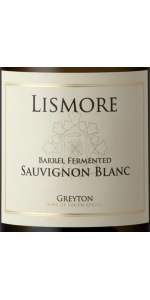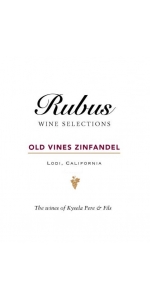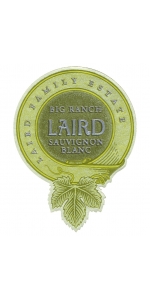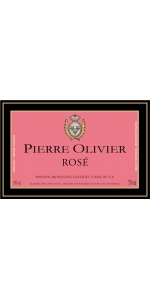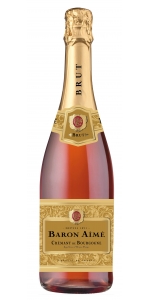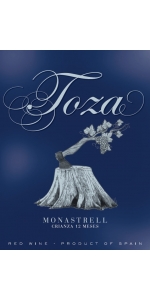Rubus New Zealand Sauvignon Blanc 2021
| Country: | New Zealand |
| Region: | Malborough |
| Winery: | Rubus |
| Grape Type: | Sauvignon Blanc |
| Vintage: | 2021 |
| Bottle Size: | 750 ml |
Rubus Sauvignon Blanc Marlborough is made from 100 percent Sauvignon Blanc.
The Rubus Project was created by Fran Kysela as a way to source & sell incredible wines at value prices. All wines in this international project are hand-selected by Fran Kysela. Rubus wines are fruit driven, true-to-type values that over deliver - a true representation of quality for the consumer at an excellent price.
Aromas of gooseberry, lemongrass, boxwood, fresh celery and bready notes on the nose. The palate is dry to taste with juicy gooseberry and citrus flavors forming a light, refreshing medium bodied wine with a tart yet soft lingering finish.
Grapes are gently pressed, settled and racked to fermentation. Juice is cool fermented in stainless steel tanks for 21 days and left on the lees for 2 months prior to blending, light fining, filtering and bottling.
The perfect accompaniment to vegetable or light seafood dishes or to enjoy before a meal.
Rubus Cabernet Sauvignon Napa Valley is made from 100 percent Napa Valley Cabernet
Its long finish displays full mature flavors of blackberry, currant and chocolate with just a hint of toasty oak and black cherry. The tannins are refined and polished, allowing the fruit to be the focus.
Lismore Barrel Fermented Sauvignon Blanc is made from 100 percent Sauvignon Blanc.
As with all Lismore wines, balance is the key. The bracing acidity that is customary in new world Sauvignons has been brought into balance with a carefully chosen pick date and the barrel and egg fermentation and maturation. A full bodied, balanced wine was the goal.
Barrel fermentation and extended lees contact contribute to this full bodied, elegant and well balanced wine. Floral notes of passion flower and fynbos, granadilla, guava, gooseberry and pear on the palate along with an underlying minerality which gives this unique terroir driven wine its signature.
Wine Made in the Soil
The grapes come from 50% Lismore’s Greyton vineyards which are planted on East/Southeast facing slopes at 320 meters in the foothills of the Sonderend Mountain Range. The soils are deep decomposed shale. The other 50% comes from a vineyard in Stanford which overlooks Walker Bay on sandstone soils.
SALE!
Lodi, American Viticulture Area (AVA) – The Lodi AVA is located in the northern end of the San Joaquin Valley, Central Valley California, east of the San Francisco Bay. Lodi has warm days and cool nights, similar to the Mediterranean climate. The lower temperatures that occur in Lodi result in fruit with good acidity. A wide range of soils are found in the Lodi AVA, but they generally are deep, loamy, sandy, rocky soils similar to that found in southern Rhone valley.
The Lodi appellation totals almost one half million acres, and the approximately eight hundred growers farm roughly 90,000 acres. Lodi produces more Cabernet Sauvignon, Chardonnay, Merlot, Sauvignon Blanc, and Zinfandel than any other wine region in California, but it is probably best known for its old vine Zinfandel. The vines are often head trained giving them a classic old world appearance.
Zinfandel – The Zinfandel grape is a hearty variety that produces grapes with high sugar levels, often resulting in wines with a high alcohol content. Thought to be a relative of Primitivo that is found in southeast of Italy (the boot heel), Zinfandel can be made into a wide range of wine styles, including White Zinfandel, light or full bodied red wines, and even late harvest desert style wine. However Zinfandel, especially Old Vine Zinfandel from Lodi, is usually made into a full bodied, spicy red wine with characteristics of red fruit, raspberry, and cherry.
Produced in the heart of Lodi AVA.
Rubus Zinfandel Lodi is made from 98% Zinfandel + 2% Cabernet Sauvignon
Bottled after aging in French and American oak for 9 months.
Rubus Zinfandel Lodi presents with ruby red in color, with red fruit, raspberry, and spice on the nose. This wine is medium in body, with notes of ripe cherry, cedar box, cinnamon, anise, black pepper, and hint of smoke on the palate. It has a long, silky finish.
Selected by Fran Kysela MS.
Laird Sauvignon Blanc Napa Valley is made from 100 percent Sauvignon Blanc
Vineyard: 100% Big Ranch Road
Appellation: Oak Knoll District of Napa Valley and Rutherford
Varietal: 100% Sauvignon Blanc
15% of Big Ranch fermented in Neutral Oak barrels + 2% of Smith Ranch fermented in Neutral Oak Barrels.
This lively and prolific varietal thrives in alluvial deposits composed of gravelly sand and gravelly loam, with good water retention and moderate fertility. Our Napa Valley Sauvignon Blanc is crafted in an approachable, fruit-forward style that is typical of the varietal and expressive of its terroir.
Tasting Notes: Translucent gold color leads to notes of juicy ripe pineapple, jasmine, Kaffir lime and Juicy Fruit gum entice the nose. Balanced, yet vibrant body of acidity tantalizes the palate with pineapple, passion fruit and Charentais Melon; a refreshing layer of minerality hits your mid-palate. The elegant, floral finish opens into a complex balance of white peaches, nectarines.
Lexicon Sauvignon Blanc is made from 100% Sauvignon Blanc
Lexicon varietal wines are carefully selected by Fran Kysela to show the essence of each variety, along with its terroir of origin, both of which are essential elements of a good wine.
Sauvignon Blanc, historically known for the great white wines of Bordeaux and Sancerre, is gaining popularity in New Zealand. Lexicon Sauvignon Blanc was produced from grapes grown in the renowned Marlborough region, on the northern end of the island. Marlborough is recognized for growing outstanding Sauvignon Blanc with mouthwatering fresh acidity, balanced by intense tropical fruit notes.
Tropical, zesty & citrusy. Hints of guava, passion fruit & gooseberries.
The Rubus Sauvignon Blanc was produced from grapes grown in selected Waipara Valley vineyards.
The extended growing season of warm, fine days and cool nights ensured the fruit was harvested in wonderful condition mid April.
This wine shows rich gooseberry and tropical fruit aromas with an edge of complexity. The palate is lively and refreshing with a long, lingering finish.
Following harvest the fruit was gently pressed, settled and racked to fermentation. The juice was then cool fermented for 21 days and left on yeast lees contact for a further two months prior to blending, light fining, filtering and bottling. Analysis at Bottling: 3.35 pH 6.5 g/l Total Acid 12 % Alcohol 2.0 g/l Residual Sugar
The Rubus Concept
Rubus wines are a private label created and used by Kysela Pere et Fils, LTD in order to buy, bottle and market wine found at incredible quality/price ratio. All Rubus wines are selected by Fran Kysela MS.
It was first used for a superb batch of 1,200 cases of Amador county Zinfandel back in 1997. The wine sold in a few days and the Rubus brand was not used since then.
During a trip in California in 2009, when Fran Kysela tasted some incredible wines (available in bottle but without label), he decided to help resurrect the brand creating an outstanding Cabernet Sauvignon from Stag's Leaps district in Napa Valley (California) , followed by an excellent Chardonnay from Russian River Valley (California)
We then developed the Rubus Zinfandel from Lodi (California).
In 2011, we added a Shiraz/Viognier blend from the Barossa in Australia.
For 2012, the newest addition to the Rubus line is a Chardonnay from Colchagua Valley in Chile.
Rubus is now its own brand representing quality for the consumer and an incredible price along the way.
Rubus Meaning
The name RUBUS means "raspberry" in Latin and it is the name given to the genus of flowering plants in the rose family. For instance, here are some famous fruit from the Rubus family with their latin names:
Rubus fruticosus agg. – Blackberry
Rubus idaeus – European Red Raspberry
Rubus occidentalis – Black Raspberry
Rubus pensilvanicus – Pennsylvania Blackberry
Rubus strigosus – American Red Raspberry
Pierre Olivier Sparkling Rose NV is a value sparkling rosé, made with Tempranillo grapes from around the French/Spanish border (next to the Pyrenees). This is a new Kysela Project.
This wine is aromatized with a very little amount of Raspberry flavor, giving a nice mouthfeel, with an extra aromatic boost.
The bubbles are obtained using the Charmat method, named after Eugene Charmat, where the second fermentation takes places in a large, closed pressurized tank. It is different from the Methode Champanoise as the secondary fermentation doesn't take place in the bottle.
"Pale pink salmon. Just a touch off-dry, this is a very pleasant sparkler that reveals aromas of spicy red apple with a hint of cinnamon that carry through to the palate. Well made and exceedingly pleasant to drink."
- International Wine Review (Annual Rosé Report / April 2013), 89 pts
Baron Aime Cremant de Bourgogne Brut Rose NV is made from 85% Pinot Noir & 15% Chardonnay.
Light pink color with coppery shades. The citrus notes blend subtly with aromas of strawberry, forming a fresh and delicate bouquet. The palate is lively, with notes of grapefruit and fresh bread. Together they form a rich, fresh and vibrant wine.
Review:
"Steely amber color. Aromas and flavors of strawberry, green apple, toasted oats, and creme fraiche with a satiny, lively, finely carbonated, dry light-to-medium body and a tingling, intricate, medium-length finish that presents overtones of slightly under ripe wild strawberries, apricot, warm bread dough, and lemon zest. Lively and bright for a perfect apéritif yet with just enough richness and body to carry you in seamlessly to the first course."
- Beverage Testing Institute (November 2022), 94 pts - GOLD MEDAL - BEST BUY
Toza Crianza Jumilla is made from 100% Monastrell (Mourvedre). Toza Crianza is a classic example of the Monastrell variety from the Mediterranean region, made from hand harvested old vines and aged 12 months in oak barrels. This Spanish red is rich, toasty, round and velvety.
Review:
Review:
"Opaque ruby. Dark berries, coconut and a hint of spiciness on the powerfully scented nose. In a round and generous style, showing very good depth and appealing sweetness to the blackberry and cherry cola flavors. Soft, even tannins add gentle grip to a long, smooth finish that leaves hints of vanilla and dark fruits behind. Raised in a combination of French and American oak barrels. - Josh Raynolds"
- Antonio Galloni's Vinous (March 2021), 90 pts
- back
Thus, the first Édition of Krug Rosé, a singular Champagne achieving an astonishing balancing act between finesse and substance, came to be.
The story of Krug Rosé dates back to 1983. With Joseph’s non-conformist spirit at heart, the 5th generation of the Krug family gave birth to a new composition, a bold rosé inspired by the House’s reputed art of blending, to be re-created each year.
Krug Rosé is an unexpected rosé Champagne combining elegance and boldness – inspired by the dream of the fifth generation of the House of Krug to conceive a rosé Champagne that did not exist, a rosé Champagne that could be re-created every year.
Krug Rosé 27ème Édition is a blend of 38 wines from 9 different years, the youngest of which is from 2015, while the oldest dates back to 2005. ▪ It was completed with 10% traditionally macerated Pinot Noir of the year blended from plots in Aÿ and Mareuil-sur-Aÿ, to add a unique spiciness, colour and structure. Its final composition is 57% Pinot Noir, 23% Chardonnay and 20% Meunier. ▪ A stay of around seven years in Krug’s cellars gives Krug Rosé 27ème Édition its unique expression and elegance.
At first sight, its subtle pale pink colour holds a promise of elegance. On the nose, aromas of rose hips, cured ham, mulberries, redcurrant, peony, pepper and pink grapefruit. On the palate, delicate flavours of honey, citrus and dried fruit with a long finish, enhanced by its fine bubbles complete the experience.
Review:
Thirty-eight wines from nine vintages spanning 2005 to 2015 - 55% of them reserve - went into this blend of 57% Pinot Noir, 23% Chardonnay, and 20% Meunier; a nonpareil of shimmering depth. On the pure, precise nose, raspberries and roses mingle with suggestions of woodsiness, honey-cured ham, and parmesan rind before vibrating with white peach and red currant, honeyed cashew, and a soupcon of tobacco leaf and cucumber on the palate - where the tension between its almost ethereal refinement, thanks not least to the unending mousse, and the luxuriance of its finish is simply (or not so simply) delicious.
-Tasting Panel 99 Points
Napa Cellars Cabernet Sauvignon is made from 100 percent Cabernet Sauvignon.
Napa Cellars Cabernet Sauvignon brims with ripe, concentrated aromas of black currant, loganberry and fig, underscored by threads of warm spice and mocha.
Review:
Aged 21 months in French and Hungarian oak, notes of toasty, spiced cocoa, cassis, and clove are the preamble for the palate’s introduction to this most approachable red. Deep and savory, with black tea, plum, and graphite. Tannins are supple and easy going, and acidity is bright, establishing an energetic finish. - The Tasting Panel, July/August 2025
-Tasting Panel/Somm Journal 92 Points

